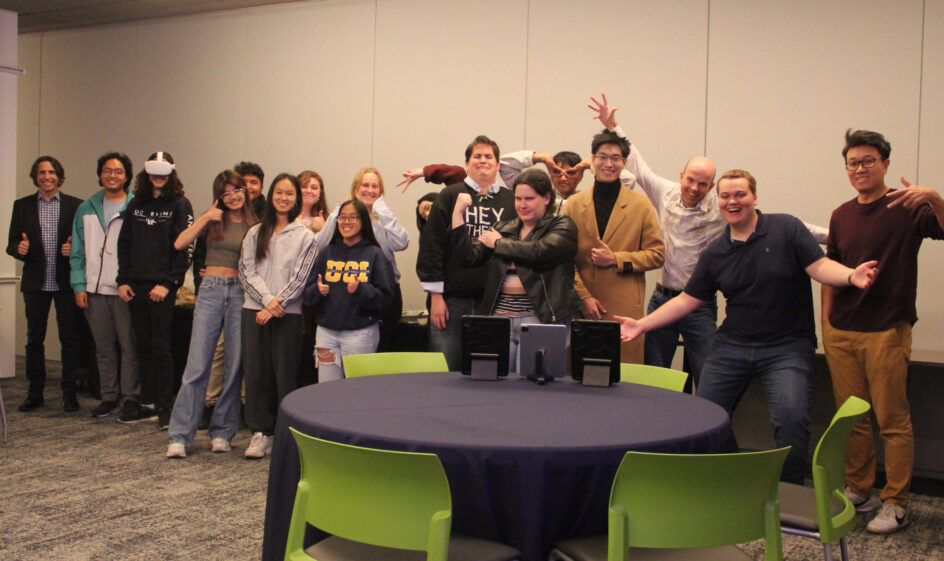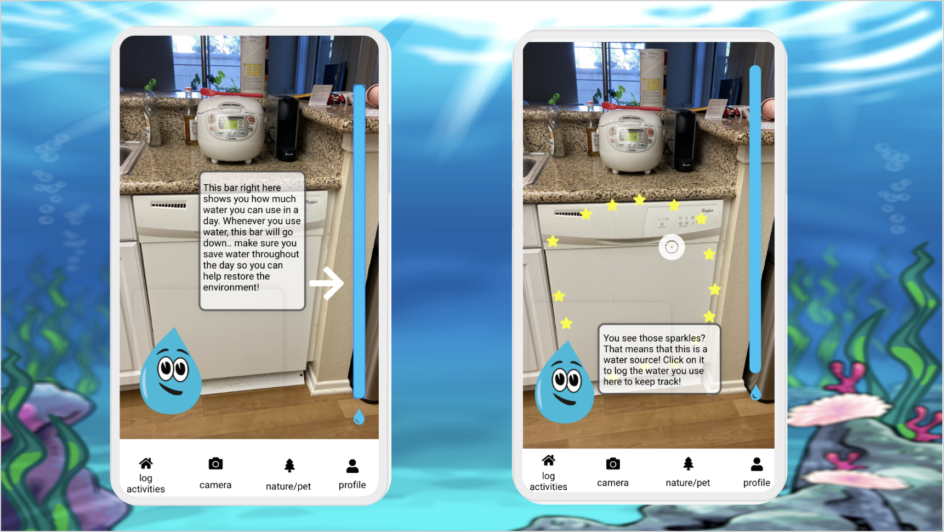Can Gaming Cool Global Warming? An Experimental Climate XR Class Aims to Inspire Change
An adorable creature with a fire-like glowing tail looks at you, pleading with its longing eyes as it is hunted to brighten a dark forest. Can you help save it by finding alternative sources of light? This is your mission in a virtual reality game called “The Darkened Pathway.” The VR world is one of five new extended reality (XR) experiences developed for Informatics 295/190: Climate XR, an experimental course offered in fall 2022 through UC Irvine’s Donald Bren School of Information and Computer Sciences (ICS).
“There is a hunger among the students, both at the graduate and undergraduate level, for classes surrounding climate as a topic,” says Informatics Professor Andre van der Hoek, who developed the course in partnership with Broadway/film producer and director Tim Kashani, an ICS alum. Van der Hoek and Kashani (co-creator of the recent Winter Lights musical at the Discovery Cube in Santa Ana) designed the curriculum specifically to explore how XR technologies might motivate people to take action against climate change. “XR has the potential of bringing [climate] issues much more up front and personal,” says van der Hoek, “showcasing possible future narratives.”

Leveraging the Power of Storytelling
The course kicked off with a guest lecture from Informatics Professor Bill Tomlinson, an expert in exploring computing as it relates to sustainability. His discussion touched on topics ranging from biodiversity loss to species extinction as he presented basic facts related to climate change. He talked about food scarcity, global conflicts, environmental migration and deforestation, highlighting headlines that called climate change an existential threat and that asked if humans will survive the sixth great extinction. Yet it was a quote from climate activist George Monbiot that set the stage for the course:
A string of facts, however well attested, will not correct or dislodge a powerful story. The only response it is likely to provoke is indignation: people often angrily deny facts that clash with the narrative “truth” established in their minds. The only thing that can displace a story is a story. Those who tell the stories run the world.
“Scare tactics gets people to look but not act,” explains Kashani. “Storytelling gets people to care.”
The 16 students enrolled in the course were then split into five teams and tasked with using XR technology to personalize the climate narrative such that people might care enough to change their behavior.
“Embedding [climate] topics in academic courses across many different disciplines is critical to engaging future generations of students,” says Tomlinson. “This course, in particular, which connects technological innovation with deep engagement with storytelling, has the potential to shape civilization-scale responses to these issues and usher in new ways of living for a more sustainable future.”
XR’s game-changing potential was on full display at the end of the quarter at UCI’s Beall Applied Innovation. The presentation of five different minimum viable products (MVPs) showcased not only technical skills gained, but also unique strategies for applying those skills to address a real-world problem.
Developing Empathy
The first to present at the end of the quarter was Team Zodiac, comprised of students with diverse academic backgrounds. Aidan McDonald is working on his BA in art, while Pranav Banuru and Alaric Yu are earning BS degrees in computer science (with Yu concentrating on software engineering). Rebecca Larkin is working on her Ph.D. in music. These team members created “The Darkened Pathway,” with the adorable yet endangered Omari species.
“There’s a risk when making a climate change game that you’ll be met with apathy,” says McDonald, who is minoring in digital art. “My goal when designing [Omari] was to make them as cute as possible so the player would get attached. I gave them rabbit-like legs and big ears and a wagging tail to make them approachable and protectable.” When players protect Omari, they can see improvements in the environment around them.

Van der Hoek referred to Omari’s effect on players as the “O” experience, noting that the game lets people “make choices (the ‘O’ experience) that map onto the real-world choices one makes daily, thus raising awareness.” The game is meant to disrupt bystander syndrome and serve as a call to action, motivating people to better care for the world around them.
“The whole concept was that, whether we’re aware or not, we make choices that affect the environment,” says McDonald. “The VR environment is a small but focused version of [the] hundreds of choices we’re forced to make in a modern landscape.” Developing the game also had an influence on his own behavior. “Working on this project inspired me to look deeper into my daily choices.”
Targeting Youth
Informatics master’s student Kelly Dickenson and Ph.D. student Sophie van Genderen took a more targeted approach with “Droppy,” their augmented reality (AR) mobile app that tracks water usage. To inspire households to care about water sustainability, they designed the game for children. “When your kids tell you that you should watch your water usage, you will probably think twice the next time you’re taking a 20-minute shower,” explained van Genderen. “This is why we focused our game on children.”

To draw kids in, they leveraged feelings of attachment to a pet. An animated water droplet, Droppy, guides players in saving water, and players are rewarded for reducing water usage with virtual pets. Droppy thus serves as a portal between the two worlds, and a multilayered incentive system has AR creatures popping up around the house. When players spot a new animal, they can adopt them for their virtual environment.

The game could be expanded for use in classrooms, schools or even across town, and it could include weekly challenges and a leader board. “We believe ‘Droppy’ can take this huge and daunting issue of water scarcity,” explained Dickenson, “and create a welcoming, positive experience that empowers future generations to enact change.”
Combining Real and Virtual Worlds
Cameron Cassidy, also a graduate student in informatics, branched off from the Droppy team to work individually on Project Water Droplet. After noting that the average American family uses more than 300 gallons of water per day at home, he presented his AR-based water tracking app, which further unites real and virtual worlds with 3D printed beacons that use sensors to track water usage. You earn gallons of water by using less than your daily allotment. You can then use the savings to cultivate vibrant AR habitats, competing or collaborating with others.

“The goal is to highlight the cumulative savings of small decisions made to conserve water throughout our day,” says Cassidy. “The gameplay centers around tracking the reduction of water usage in communal spaces, such as schools or workplaces, brought about by water conservation signage or awareness campaigns.”
Mimicking an Ecosystem
Another solo project was by informatics Ph.D. student Shenshen Han, who built on his earlier work with BioSim, a suite of simulation tools that use electronic-enhanced puppets to engage elementary school children during science education. To simplify BioSim’s development process and make the tools more sustainable, Han transformed a BioSim activity about bees and their ecosystem, called BeeSim, into “BeeSim AR” for classroom deployment or a fun family activity. Similar to the classroom puppet activity, the mobile AR version has honeybees searching for flowers. As players roam a room trying to fill their bee’s three empty nectar slots, they learn to care about bees and their environment and understand how individual actions can affect an entire system.
At the same time, Han also gained quite a few technical skills. “I learned a great deal about 3D modeling and machine learning techniques while implementing this AR game,” he says, “since my initial plan was to leverage object-recognition techniques to allow players to interact with real flower objects in the AR game space to encourage users to play outdoors and engage in a plant environment.”

Creating a Sense of Urgency
The last team to present took a different approach with “Toxicity Rising,” an immersive 60-minute VR escape room experience. The sense of urgency is immediate for the “Toxicity Rising” player, who is trapped in a car factory that is quickly sinking because of its location on a melting glacier. Finding a way out involves solving a series of interactive puzzles, all of which raise awareness about how our daily actions impact global warming. For example, the puzzles for escaping the kitchen address emissions from meat production, and throughout the game, players can click on various objects to learn more information. Players come to the realization that their work at the factory producing carbon-emitting cars has contributed to the rising sea level that has put them in this life-threatening situation.

“Toxicity Rising” is the product of a seven-member team, with three UI/UX specialists (ICS students Jorina Chen, Minh Nguyen and Jingjing Wang), three programming specialists (ICS students Tim Kashani [Kashani’s son], Uziel Adrian Martinez and Gregory Sinaga), and one art specialist (art major Brenna Chiaramonte). They settled on the idea of an escape room to leave a lasting impression without “lecturing” players. “The main goal of our game is to magnify the consequences of actions and let the players generate their own understanding of carbon emissions while solving the puzzles,” says Wang. “Players will find out that ‘Toxicity Rising’ is not an imaginary game but actually a real-life simulation. What’s in the game — cars, meat, plastic bags, etc. — is also in our daily lives, and what’s happening in the game is also happening in real life.” The team plans to continue working on the game this quarter through independent study, adding a few more students to round out the skill sets.
Building on the Experiment
In addition to individual projects moving forward through independent study, van der Hoek and Kashani are now brainstorming on what comes next for the experimental course, which they deemed a success. “My goal was to see if the students could use storytelling, game design and creativity to make the climate challenge aspirational rather than dystopian,” says Kashani. “They all created MVPs that can someday go commercial.”
Van der Hoek agrees and says they are looking for ways to move forward with the concepts and continue with the course offering in future quarters. “Bringing together an interdisciplinary set of students can lead to novel, diverse and super interesting designs for XR applications,” he says. “And it can educate the next generations in concrete and exciting ways.”
“They’re going to have to bear the weight of climate change,” adds Kashani. “This is an opportunity for them to carve out what the future is going to be.”
— Shani Murray